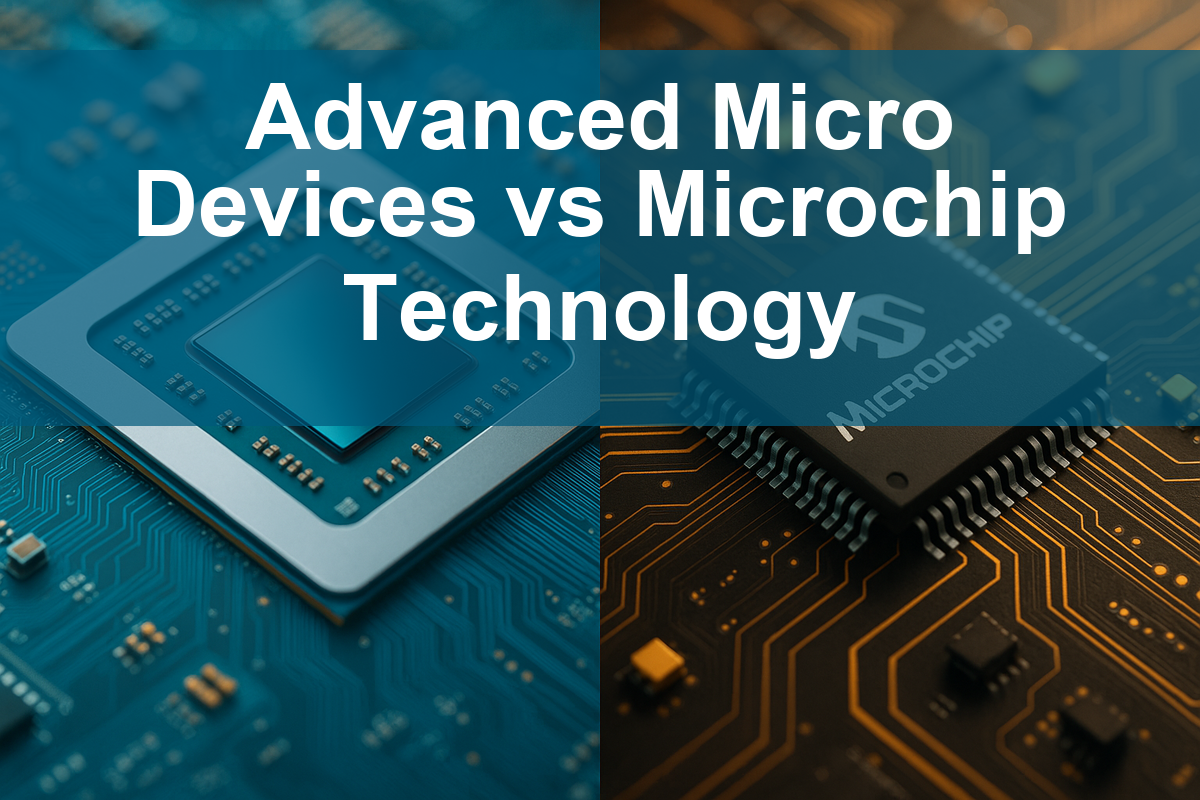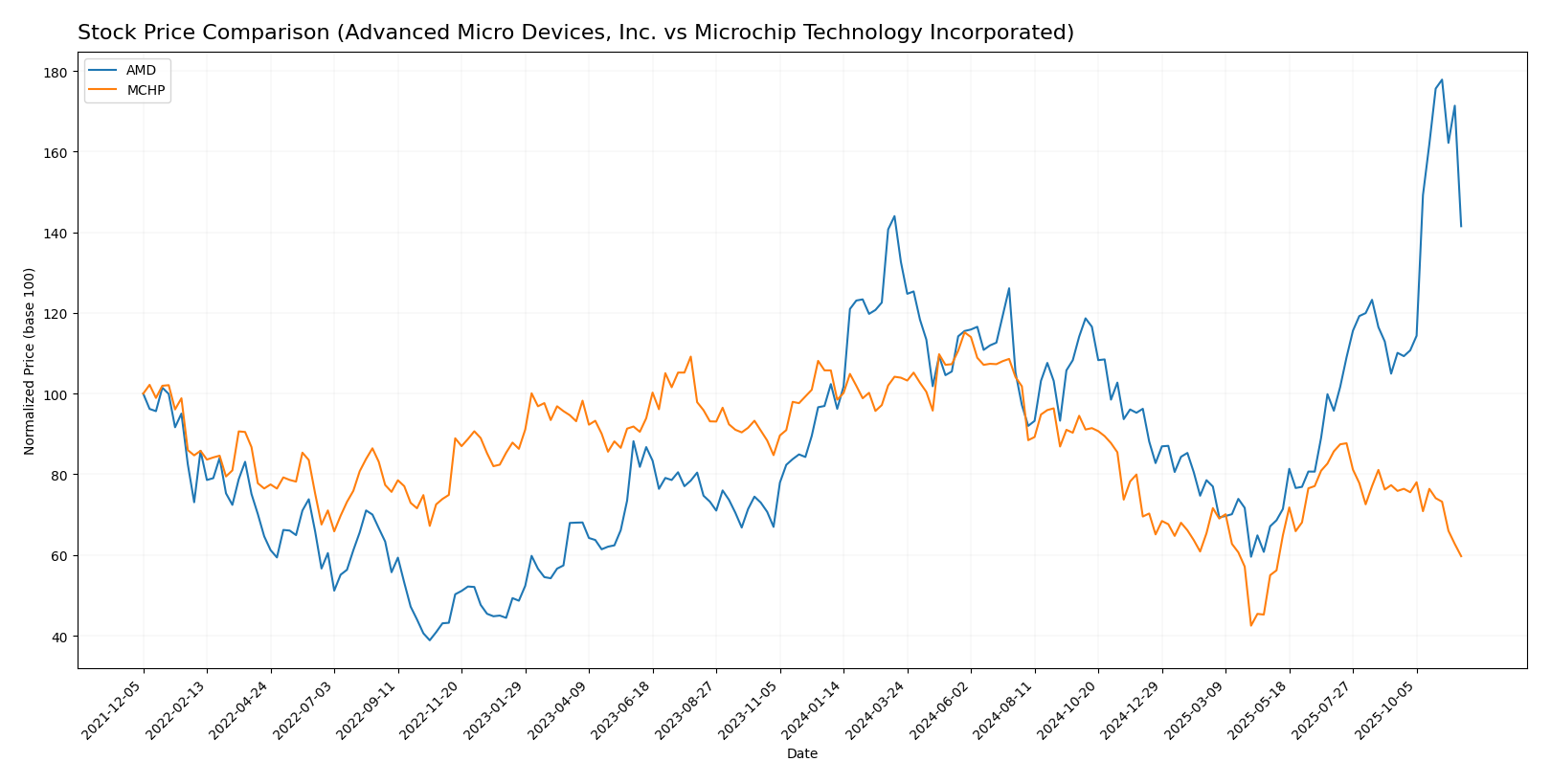In the fast-evolving semiconductor industry, two key players, Advanced Micro Devices, Inc. (AMD) and Microchip Technology Incorporated (MCHP), are shaping the future of technology with innovative solutions. Both companies operate within the same sector but focus on different market segments—AMD excels in high-performance computing and graphics, while MCHP specializes in embedded control solutions. In this article, I will analyze these companies to help you, the investor, determine which one presents the most compelling investment opportunity.

Table of contents
Company Overview
Advanced Micro Devices, Inc. Overview
Advanced Micro Devices, Inc. (AMD) is a leading semiconductor company known for its innovative processors and graphics technologies. Operating primarily in the Computing and Graphics segment, AMD’s product lineup includes x86 microprocessors, chipsets, and both discrete and integrated graphics processing units (GPUs). With a market capitalization of approximately $353B, AMD has carved a niche in high-performance computing, catering to both consumer and enterprise markets. The company’s focus on developing cutting-edge technology places it as a strong competitor against industry giants, continuously pushing the envelope in gaming and data center applications. Under the leadership of CEO Lisa T. Su, AMD has expanded its portfolio, including the popular Ryzen and EPYC processor families, thereby solidifying its position as a driver of innovation in the technology sector.
Microchip Technology Incorporated Overview
Microchip Technology Incorporated (MCHP) specializes in embedded control solutions, manufacturing a diverse range of microcontrollers and microprocessors. The firm, with a market cap of approximately $29B, caters to various applications across automotive, industrial, and communications sectors. Microchip’s extensive product offerings, including specialized microcontrollers and development tools, target a wide array of markets, making it a prominent player in the semiconductor industry. CEO Stephen Sanghi has led the company since its inception, driving growth through strategic acquisitions and a focus on high-quality products. MCHP’s emphasis on secure and connected technologies positions it well to meet the increasing demand for embedded solutions in an ever-evolving tech landscape.
Key similarities and differences
Both AMD and Microchip Technology operate within the semiconductor industry, serving high-tech markets with innovative products. However, AMD focuses on high-performance computing and graphics solutions, while Microchip emphasizes embedded control and connectivity technologies. This distinction in product offerings highlights their unique approaches to meeting diverse market demands.
Income Statement Comparison
Below is a comparison of the income statements for Advanced Micro Devices, Inc. (AMD) and Microchip Technology Incorporated (MCHP) based on the most recent fiscal year.
| Metric | AMD | MCHP |
|---|---|---|
| Market Cap | 353.04B | 28.87B |
| Revenue | 25.79B | 4.40B |
| EBITDA | 5.26B | 1.04B |
| EBIT | 2.08B | 0.29B |
| Net Income | 1.64B | -0.00B |
| EPS | 1.01 | -0.005 |
| Fiscal Year | 2024 | 2025 |
Interpretation of Income Statement
In the recent fiscal year, AMD experienced significant revenue growth of approximately 13.7% compared to the prior year, contributing to a net income increase as well. Conversely, MCHP’s revenue declined sharply from 7.63B to 4.40B, resulting in a net loss, reflecting challenges in operational efficiency. AMD’s EBITDA margin improved, indicating better cost management, while MCHP’s margins deteriorated, highlighting the need for strategic adjustments. Overall, AMD’s performance indicates robust growth, while MCHP’s situation warrants caution as it navigates through financial difficulties.
Financial Ratios Comparison
The following table presents a comparative overview of the most recent revenue and financial ratios for Advanced Micro Devices, Inc. (AMD) and Microchip Technology Incorporated (MCHP).
| Metric | AMD | MCHP |
|---|---|---|
| ROE | 2.85% | -0.007% |
| ROIC | 2.49% | 2.08% |
| P/E | 123.59 | 20.61 |
| P/B | 3.52 | 7.08 |
| Current Ratio | 2.62 | 2.59 |
| Quick Ratio | 1.83 | 1.47 |
| D/E | 0.04 | 0.80 |
| Debt-to-Assets | 0.04 | 0.40 |
| Interest Coverage | 20.65 | 1.18 |
| Asset Turnover | 0.37 | 0.29 |
| Fixed Asset Turnover | 10.63 | 3.72 |
| Payout Ratio | 0% | 31.07% |
| Dividend Yield | 0% | 1.51% |
Interpretation of Financial Ratios
In comparing AMD and MCHP, AMD exhibits a significantly higher P/E ratio, indicating that investors are willing to pay a premium for its earnings compared to MCHP. However, MCHP demonstrates a more favorable debt-to-equity ratio and dividend yield, suggesting greater financial stability and income potential for investors. Notably, MCHP’s negative return on equity raises concerns about its profitability, while AMD’s healthy interest coverage ratio highlights its ability to meet interest obligations effectively.
Dividend and Shareholder Returns
Advanced Micro Devices, Inc. (AMD) does not pay dividends, opting instead to reinvest earnings for growth, evident in its aggressive R&D spending. Despite lacking a dividend, AMD engages in share buybacks, reflecting confidence in its long-term value creation potential. Conversely, Microchip Technology Incorporated (MCHP) distributes a dividend with a yield of 3.75% and a payout ratio of 47.8%, suggesting a balanced approach between rewarding shareholders and maintaining growth. Both strategies align with sustainable long-term value creation, yet they reflect different priorities for each company.
Strategic Positioning
In the semiconductor market, Advanced Micro Devices, Inc. (AMD) holds a significant market share with a robust portfolio in computing and graphics, notably competing with Intel and NVIDIA. With a market cap of 353B, AMD faces intense competitive pressure but leverages technological innovations in AI and gaming. Meanwhile, Microchip Technology Incorporated (MCHP), with a market cap of 29B, specializes in embedded control solutions, targeting diverse sectors including automotive and industrial applications. Both companies are navigating technological disruptions, emphasizing the importance of continual innovation to maintain their market positions.
Stock Comparison
In the past year, Advanced Micro Devices, Inc. (AMD) has demonstrated significant price movements, highlighted by a robust upward trend, while Microchip Technology Incorporated (MCHP) has faced notable challenges, resulting in a declining trajectory.

Trend Analysis
AMD has experienced a remarkable price change of +56.97% over the last 12 months. This bullish trend is supported by an acceleration in price movements, with notable highs reaching $256.12 and lows at $85.76. The volatility, indicated by a standard deviation of 35.8, reveals a relatively high level of price fluctuation. Recent data shows a price increase of +37.18% from September 14, 2025, to November 30, 2025, further reinforcing the bullish sentiment.
MCHP, on the other hand, has seen a decline of -36.21% over the same period, indicating a bearish trend marked by deceleration. The stock’s highest price was $98.23, while the lowest was $36.22, with a standard deviation of 14.87 suggesting lower volatility compared to AMD. Recently, MCHP’s price has dropped by -17.19% from September 14, 2025, to November 30, 2025, confirming the ongoing bearish outlook.
Analyst Opinions
Recent analyst recommendations for Advanced Micro Devices, Inc. (AMD) indicate a solid “Buy” rating, reflecting strengths in return on assets and overall financial health, with a notable score of 3 in discounted cash flow analysis. Analysts appreciate AMD’s growth potential despite some concerns over its price-to-earnings ratio. In contrast, Microchip Technology Incorporated (MCHP) received a “Sell” rating, primarily due to lower scores in return on equity and price-to-book ratios. The consensus for the current year leans towards a buy for AMD while MCHP is viewed unfavorably.
Stock Grades
In this section, I present the latest stock ratings for Advanced Micro Devices, Inc. (AMD) and Microchip Technology Incorporated (MCHP), based on reliable grading data.
Advanced Micro Devices, Inc. Grades
| Grading Company | Action | New Grade | Date |
|---|---|---|---|
| Mizuho | maintain | Outperform | 2025-11-12 |
| Evercore ISI Group | maintain | Outperform | 2025-11-12 |
| Rosenblatt | maintain | Buy | 2025-11-12 |
| B of A Securities | maintain | Buy | 2025-11-12 |
| Morgan Stanley | maintain | Equal Weight | 2025-11-12 |
| Wedbush | maintain | Outperform | 2025-11-12 |
| Piper Sandler | maintain | Overweight | 2025-11-12 |
| Wells Fargo | maintain | Overweight | 2025-11-12 |
| Roth Capital | maintain | Buy | 2025-11-12 |
| Wedbush | maintain | Outperform | 2025-11-10 |
Microchip Technology Incorporated Grades
| Grading Company | Action | New Grade | Date |
|---|---|---|---|
| Truist Securities | maintain | Hold | 2025-11-07 |
| Susquehanna | maintain | Positive | 2025-11-07 |
| Citigroup | maintain | Buy | 2025-11-07 |
| Stifel | maintain | Buy | 2025-11-07 |
| Wells Fargo | maintain | Equal Weight | 2025-11-07 |
| Cantor Fitzgerald | maintain | Neutral | 2025-11-07 |
| Needham | maintain | Buy | 2025-11-07 |
| Morgan Stanley | maintain | Equal Weight | 2025-11-04 |
| Needham | maintain | Buy | 2025-08-08 |
| Piper Sandler | maintain | Overweight | 2025-08-08 |
Overall, the grades for both AMD and MCHP reflect a generally positive sentiment among analysts, with several “Buy” and “Outperform” ratings indicating continued confidence in their market positions. Notably, MCHP has received consistent “Buy” ratings from multiple firms, which may indicate a strong outlook for the company.
Target Prices
The current consensus target prices from analysts suggest potential upward movement for both companies.
| Company | Target High | Target Low | Consensus |
|---|---|---|---|
| Advanced Micro Devices, Inc. | 380 | 200 | 295.24 |
| Microchip Technology Incorporated | 83 | 60 | 71.33 |
Analysts expect Advanced Micro Devices (AMD) to reach a consensus target price of 295.24, significantly above its current price of 217.52. Microchip Technology (MCHP) has a consensus of 71.33, which is also above its current price of 53.58, indicating positive sentiment for both stocks.
Strengths and Weaknesses
The following table outlines the strengths and weaknesses of Advanced Micro Devices, Inc. (AMD) and Microchip Technology Incorporated (MCHP) based on the most recent data.
| Criterion | AMD | MCHP |
|---|---|---|
| Diversification | Strong product range in computing and graphics | Diverse embedded solutions across sectors |
| Profitability | Net Profit Margin: 6.36% | Net Profit Margin: -0.01% |
| Innovation | High R&D investment | Steady innovation in microcontrollers and FPGAs |
| Global presence | Strong global footprint | Significant presence in Americas and Asia |
| Market Share | Growing in semiconductors | Stable in embedded systems |
| Debt level | Low Debt-to-Equity: 0.04 | High Debt-to-Equity: 0.80 |
Key takeaways from this analysis indicate that AMD exhibits strong profitability and innovation, with a low debt level, making it a more attractive option than MCHP, which currently struggles with profitability and has a higher debt burden.
Risk Analysis
The following table outlines the key risks associated with Advanced Micro Devices, Inc. (AMD) and Microchip Technology Incorporated (MCHP).
| Metric | AMD | MCHP |
|---|---|---|
| Market Risk | High | Moderate |
| Regulatory Risk | Moderate | High |
| Operational Risk | Moderate | High |
| Environmental Risk | Low | Moderate |
| Geopolitical Risk | Moderate | High |
In summary, AMD faces high market risk due to its volatile stock performance, with a beta of 1.913. MCHP, while exhibiting moderate market risks, encounters significant regulatory pressures and operational challenges, which could impact its profitability moving forward.
Which one to choose?
When comparing Advanced Micro Devices (AMD) and Microchip Technology (MCHP), AMD shows stronger fundamentals, reflected in its revenue growth and higher profitability margins. AMD’s gross profit margin stands at 49.35% compared to MCHP’s 56.07%, but its overall financial health is more favorable with a better return on equity (ROE) and a solid current ratio of 2.62, indicating liquidity. Analysts rate AMD a “B” while MCHP receives a “C-,” suggesting that AMD is perceived as a more robust investment. However, MCHP offers a dividend yield of 3.75%, appealing to income-focused investors.
For growth-oriented investors, AMD appears favorable, while those seeking dividends and stability may consider MCHP. Be mindful of risks such as AMD’s high valuation metrics and MCHP’s recent performance trends, which indicate a bearish outlook.
Disclaimer: This article is not financial advice. Each investor is responsible for their own investment decisions.
Go further
I encourage you to read the complete analyses of Advanced Micro Devices, Inc. and Microchip Technology Incorporated to enhance your investment decisions:



